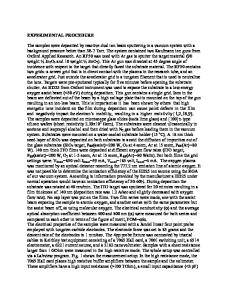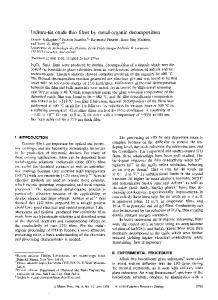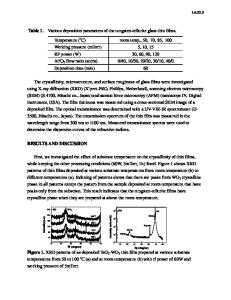Thermal degradation behavior of indium tin oxide thin films deposited by radio frequency magnetron sputtering
- PDF / 239,928 Bytes
- 6 Pages / 612 x 792 pts (letter) Page_size
- 71 Downloads / 421 Views
Yeon-Gil Jung Department of Materials Science and Engineering, Changwon National University, Changwon, Kyungnam 641-773, Republic of Korea (Received 26 January 2005; accepted 24 March 2005)
The thermal degradation behavior of indium tin oxide (ITO) thin films coated on glass substrates using radio frequency (rf) magnetron sputtering was investigated over the temperature range of 100–400 °C in air. The resistivity of ITO films increases abruptly after the thermal degradation temperature of 250 °C is reached, with a slight increase from 200 to 250 °C. The x-ray photoelectron spectrometry intensity ratio of O/(In + Sn) in thermally degraded ITO films is higher than that in normal films. The carrier concentration gradually decreases up to 200 °C, sharply drops between 200 and 250 °C with increasing temperature, and then saturates from 275 °C. The Hall mobility drops suddenly at 275 °C. The diffusion of oxygen into oxygen interstitials and oxygen vacancies and the chemisorption of oxygen into grain boundaries decrease the carrier concentration and the Hall mobility, respectively. The former mainly affects the resistivity of ITO films below 250 °C, and the later above 250 °C.
I. INTRODUCTION
Indium tin oxide (ITO) is an advanced ceramic material with many applications in electronics due to its high electrical conductivity and transparency to visible light. ITO is an n-type degenerate semiconductor, and both oxygen vacancies and substitutional Sn4+ replaced at In3+ sites contribute to its high carrier concentration. Therefore, ITO films have been used as transparent electrodes for display devices, transparent coatings for solar energy heat mirrors, and transparent contacts in advanced optoelectronic devices such as solar cells, light emitting and photo diodes, photo transistors and lasers.1,2 There are several factors that cause decay in the efficiency and, ultimately, failure of electronic devices.3–6 One of the main factors determining the lifetime of electronic devices is degradation of, or damage to, ITO films.5,6 In addition, the quality of devices depends largely on the quality of their ITO films.7 ITO films acquire a thermal history during fabrication, and the normal operating conditions of electronic devices require very high electric fields. These conditions vary their properties. In particular, as high electric fields induce
a)
Address all correspondence to this author. e-mail: [email protected] DOI: 10.1557/JMR.2005.0199 1574
http://journals.cambridge.org
J. Mater. Res., Vol. 20, No. 6, Jun 2005 Downloaded: 12 Feb 2015
joule heating, thermal degradation in ITO films may be expected. Therefore, estimation and understanding of the thermal degradation behavior of ITO films is essential to overcoming the deterioration in performance and improve the lifetime and quality of electronic devices. The present paper reports the thermal degradation behavior of ITO films coated on glass substrates by radio frequency (rf) magnetron sputtering at high temperatures in air. The thermal degradation behavior is investiga
Data Loading...











